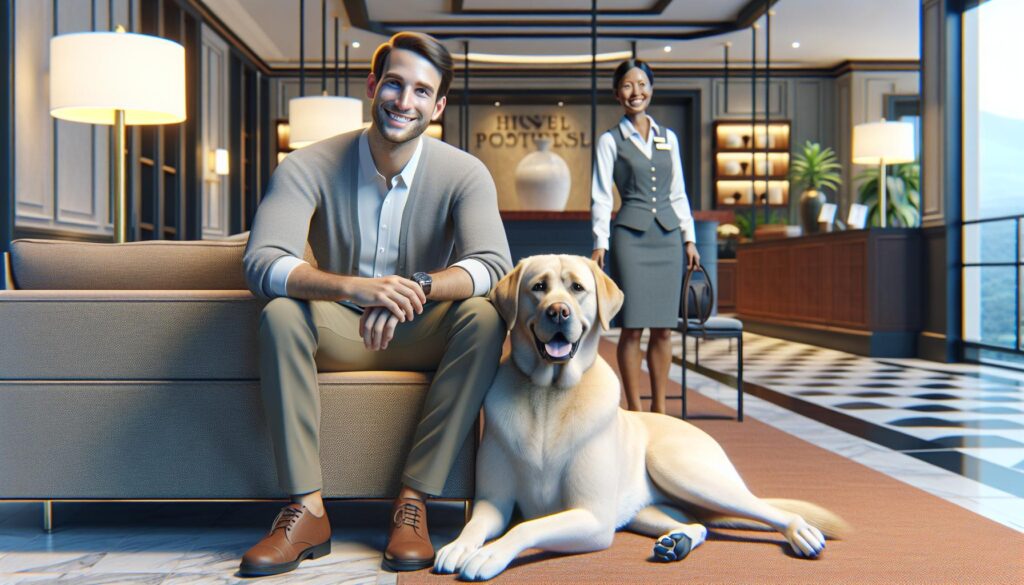Dogs are man’s best friend for a reason. They tend to be super loyal and protective. They also provide unconditional support, comfort, and love.
Many owners appreciate this love so much that they don’t want to keep it all for themselves. If you want to share your pup’s love with others, you can!
One way to do this? Training and registering your pup as a therapy dog.
Having a therapy dog is a great way to spend more time with your pet, and you both will make a big impact on the community as dog therapy can bring lots of joy and comfort.
The training and registration process can seem daunting, but it’s totally worth the impact you’ll have.
In this guide, we make it as simple as possible. Here’s everything you need to know about training and registering a therapy dog.
What is a Therapy Dog?
Service dogs. Emotional support animals. Therapy dogs.
People often use these terms interchangeably, but it’s important to note that they are very different.
- Service dogs go through rigorous training to assist a handler with their disability. Examples include a service dog for the blind, a service dog that monitors seizures, etc. These therapy animals have special protections under the Americans with Disabilities Act (ADA). Organizations must allow them to accompany their owner wherever the public is usually allowed. (The ADA does not classify emotional support animals or therapy dogs as service dogs.)
- Emotional support animals provide comfort and help alleviate symptoms of their owner’s disability. They do not receive specific training or necessarily need training at all. To qualify your pup as an emotional support animal, you need to obtain a letter of recommendation from a licensed healthcare professional.
- Therapy dogs are not service dogs or emotional support animals. Therapy dogs are certified to volunteer with their owners at hospitals, schools, and other venues. They provide love and affection to students, nursing home patients, those with a health condition, etc.
Sounds like something you would like to do with your pup? Read on for more info about training and certification!
Choosing the Right Breed
Before we go any further, it’s important to know what breeds are eligible to be therapy dogs.
Technically speaking, any breed is eligible for certification. So, it doesn’t matter whether you have a tiny chihuahua or a massive Great Dane.
But, just because all breeds are eligible doesn’t mean that all pups make good therapy dogs. Your pet needs to have the right temperament and personality. And, of course, some breeds are naturally more suited for this kind of work.
You’ll want a pet that is obedient and not too hyper. They should be comfortable with other people, and they should enjoy receiving lots of attention.
Training a Therapy Dog
Hospitals, schools, and nursing homes are always on the lookout for therapy dogs. They recognize the benefits dog therapy brings to their patients and students.
But, most organizations won’t let your pup visit unless they are certified. This makes sense as they don’t want just any animal interacting with their patients. Therapy dog certification ensures that the therapy animal is well-behaved and knows how to properly provide comfort.
Your pup will need a little therapy dog training before becoming a certified therapy dog. Some owners choose to do this themselves. Others might seek out the help of a private trainer or go to group classes.
Here are some specific things you’ll want to focus on during therapy dog training:
Desensitization
Therapy dogs see a lot on the job. They interact with many different kinds of people. And they constantly come across new environments and scenarios.
Unfamiliar people and settings can scare some pups. They may cause anxiety and even prevent your pup from fulfilling their role.
This is why desensitization training is so important. By getting your pet comfortable with the unfamiliar, they’ll be better prepared to do their job.
The earlier you start desensitization training, the better. Puppies are more receptive to being exposed to new things. It may take older canines longer to acclimate to unfamiliar settings.
But, keep in mind that dogs of all ages can respond positively to desensitization training.
Start by introducing your furry friend to new people. Lots of new people. Make sure they meet and interact with lots of different individuals. They should be comfortable with those who are young, old, loud, quiet, have facial hair, wear hats, etc. This will ensure they are friendly with any stranger they come across.
Aside from meeting new people, your pup should be comfortable with being in different environments. You should acclimate them to hospitals, schools, and other unfamiliar settings. You should also acclimate them to loud noises and other strange situations.
Basic and Intermediate Obedience Training
Your pup doesn’t have to know any fancy tricks. But, they need to be obedient. Obedience ensures you have full control of them during visits.
Start by teaching your pup easy commands. They should listen to and promptly comply with “sit,” “stay,” “come,” “leave it,” etc.
Canine Good Citizen Program
If you want a good benchmark to go by, use the Canine Good Citizen (CGC) program.
The goal of this program from the American Kennel Club (AKC) is to get your pup to master ten key skills. Skills include sitting politely for petting, coming when called, etc. To help you reach these goals, the AKC provides helpful training resources on its site.
Some owners choose to simply use the CGC to guide their training. If you choose, you can seek out an official CGC evaluator in your area. They will formally test your pup and award them the CGC title if they pass.
Some therapy dog certification organizations require your pup to have the CGC title. Even if the organization you choose doesn’t require it, a CGC title is a step in the right direction. Most pets who pass the CGC test have no problem passing the therapy dog certification test.
Therapy Dog Certification Requirements
Once you feel your pup is adequately trained, it’s time to get your therapy animal certified.
You’ll need to go through a reputable therapy dog certification organization. This will ensure that your pup can make visits to hospitals, schools, etc.
View a list of AKC-recognized certification organizations here. Make sure to do your research to find one that is right for you and has evaluators in your area.
Most organizations have similar requirements. For instance, the therapy dog must be at least one year old. Also, a therapy dog must be healthy and up to date on its vaccinations.
While many of their requirements are the same, organizations may have different policies. For instance, some require your pup to complete official training courses or earn the CGC title. Others will test your pup even if they haven’t had formal training.
To ensure you’re on the right track, familiarize yourself with your organization’s policies.
How Do I Register My Therapy Dog?
Again, the registration process will differ based on the organization you choose. It usually goes something like this:
You start by registering online. You have to fill out paperwork and submit any required documentation (vet records, etc.). You may also have to submit a background check.
- Once the organization approves your registration, you have to find an official evaluator in your area. You meet up with the evaluator on the scheduled test date.
- The evaluator will test your pup on skills similar to the ones in the CGC program. They will also evaluate your capabilities as a therapy dog handler to determine if you two make a good therapy dog team.
- If you pass this initial phase, you’re on your way to certification! You will have to complete a few supervised visits to ensure that you and your pup work well in real scenarios.
- After that, you will be able to complete your own visits! To remain in good standing, most therapy dog organizations require you to complete at least one visit every three months or so.
Even after your pup is certified, it’s your responsibility to keep up with their training. This will ensure that they continue to do a great job.
Please note that ESA Registration offers products to label your animal as a therapy dog, but is not an accredited organization recognized by the American Kennel Club. Registering on our site helps keep therapy dog owners up to date on any legal changes that can impact their pup. Further, we offer several therapy dog products such as harnesses and patches to make your life easier when in a hospital, senior living facility, or other area therapy dogs are known to travel. Still, we recommend you go through the required steps to make your dog into a therapy dog.
Something to Keep in Mind
As we mentioned earlier, therapy dog organizations accept all breeds. However, this doesn’t necessarily mean that you and your pup are a good fit.
During the training process, you might realize that your pup isn’t cut out for this line of work. Your pup must enjoy interacting with strangers. You never want to force it; not only will your pup not do a great job, but they’ll also be miserable.
During training, you may even realize that the problem is you, not them. Not everyone is cut out to be a therapy dog handler. The job requires lots of patience and socializing. Be honest with yourself – it’s never too late to rethink your decision if it’s best for you and your dog.
A Rigorous Yet Rewarding Process
The training and certification process can be rigorous. You have to jump through many hoops and check lots of boxes. But, in the end, it’s totally worth it! You and your pup will be spreading love and giving back to your community.
Register your therapy dog today to get started.
Resources:
https://www.servicedogcertifications.org/how-to-register-a-therapy-dog/
https://www.servicedogcertifications.org/how-to-certify-a-therapy-dog/











